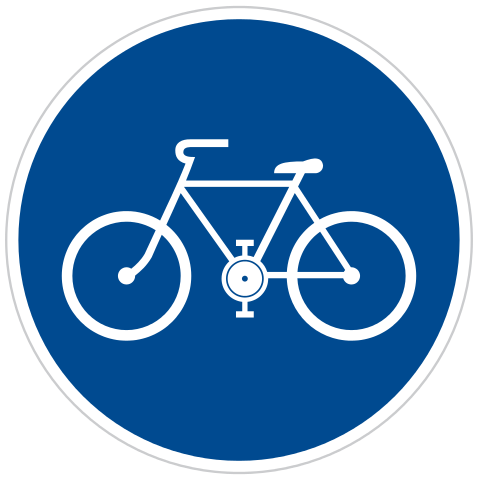Ignoring that my country doesn’t allow Idaho Stops, or that my Provincial Government wants to actively kill cyclists by removing safe cycling infrastructure, I’ve always wondered if there’s a reason why cyclists aren’t allowed to simply ride through an intersection like the one in the photo.
I’m talking about the right side, where the bike lane could extend through the intersection without interfering with other vehicles, including those that are turning left.
This would not only keep those stops safer (clears the cyclist out of the intersection), but would just make sense from a transportation efficiency standpoint.
Is there something I’m missing, or do cyclists have to stop only because motorists would take a tantrum if they weren’t required to?


So, respect cyclists as much as car drivers, except when it’s inconvenient for you to follow the rules of the road?
Intersections are probably the most dangerous place on the road, or at least that’s what I was taught in motorcycling class 40 years ago.
If a cyclist can ride right through this, why can’t I on my 125 motorcycle?
And yes, I disagree with filtering. I understand the arguments for it, but it introduces so much risk as cagers aren’t looking for you.
Perhaps it should be allowed! Cars already treat stop signs as yields (“California Roll” is the car corollary to the “Idaho Stop”). Why would you stop if the car behind you isn’t planning to? (I’d love to see motorbike studies on this; please link me to some if you know any.)
Studies have shown that cyclists treating stop signs as yield signs leads to fewer accidents, both with cars and pedestrians.
Yielding also decreases time spent in the intersection. You have a motor underneath you. Cyclists don’t. Clearing the intersection quickly prevents cross-traffic from splatting you. That’s why slowing down, checking for traffic, but not stopping is so important for momentum vehicles.
The NHTSA (the US road safety org for my Canadian friends) has a good two-pager overview. It’s a good place to start if you’re still curious about the reasoning behind the Idaho stop.
Just to put this out there: this isn’t really about convenience, but safety. My question is basically “why isn’t an Idaho Stop permitted at a 3-way shown in the photo?”.
Since we know that Idaho Stops are SIGNIFICANTLY safer for cyclists (and yes, it can be more convenient as a secondary benefit), it’s not really about respecting or following rules, but “does this rule make sense for a cyclist, when it offers no benefit to safety?”.
Yes, if you are driving in the middle of the road, not in the gutter lane. And usually at 4-way intersections where vehicles cross each other’s path. You get none of that in this context.
As above, that would be dangerous. Unless you can provide evidence that blowing through stops on a motorcycle is actually safer for you.
@Showroom7561 @BearOfaTime This got boosted onto my timeline so I’m gonna drop in something which I’ve had confirmed by other bicyclists:
Motorcycle guy: you accelerate like a car. You don’t accelerate like a bike, particularly not a standard (non-electric) bike.
A bike which does an “Idaho stop” has a perceived entry into the intersection a lot more like yours than like that of a bicyclist starting from a full stop. We can agree on that, right? You’re already at a fair speed when drivers see you.
Now here’s something I’ve noticed as someone with an eBike.
If I turn on assist and do a high-acceleration entry into an intersection from a full stop, CARS TREAT ME LIKE A CAR, and respect my right of way.
If I _don’t_ do that, they _don’t_.
@Showroom7561 @BearOfaTime It doesn’t matter what my speed is halfway or 2/3rds of the way through the intersection. They are _way_ more likely to try to nose in around me, or merge into me, or fuck knows what else if I _don’t_ have that initial fast acceleration.
I’m pretty sure it’s not with intent. And obviously, it’s not all the time. But it’s real.
I started experimenting with this after doing the quick-acceleration at high-volume road intersections just to get the hell out of there faster. I decided _not_ to do it for a few days and see how that went. I wasn’t going slow, I was still doing a good speed manual acceleration and not taking meaningfully more time than cars.
Didn’t matter. The difference in driver behaviour was _stark_.
@Showroom7561 @BearOfaTime On a motorcycle, you have that initial acceleration like a car _all the time_, just like an automobile has.
I’m pretty sure it provides you a little bit of extra production analogue/standard bikes don’t have. And I suspect - don’t know, but _suspect_ - that an Idaho Stop emulates the same thing.
That initial acceleration is one of the many differences between bikes and motorcycles and maybe something to think about.
(I also used to ride a motorbike. I know cars don’t respect them. And because I know what that feels like, I know from personal experience that _this_ is different, and worse.)
@Showroom7561 @BearOfaTime (My _suspicion_ is that they see the slower initial acceleration of a manual bike and something in their brain decides “walking speed” and they make very, very bad and very, very wrong decisions based on that. But now I’m _really_ just guessing and have no real idea.)